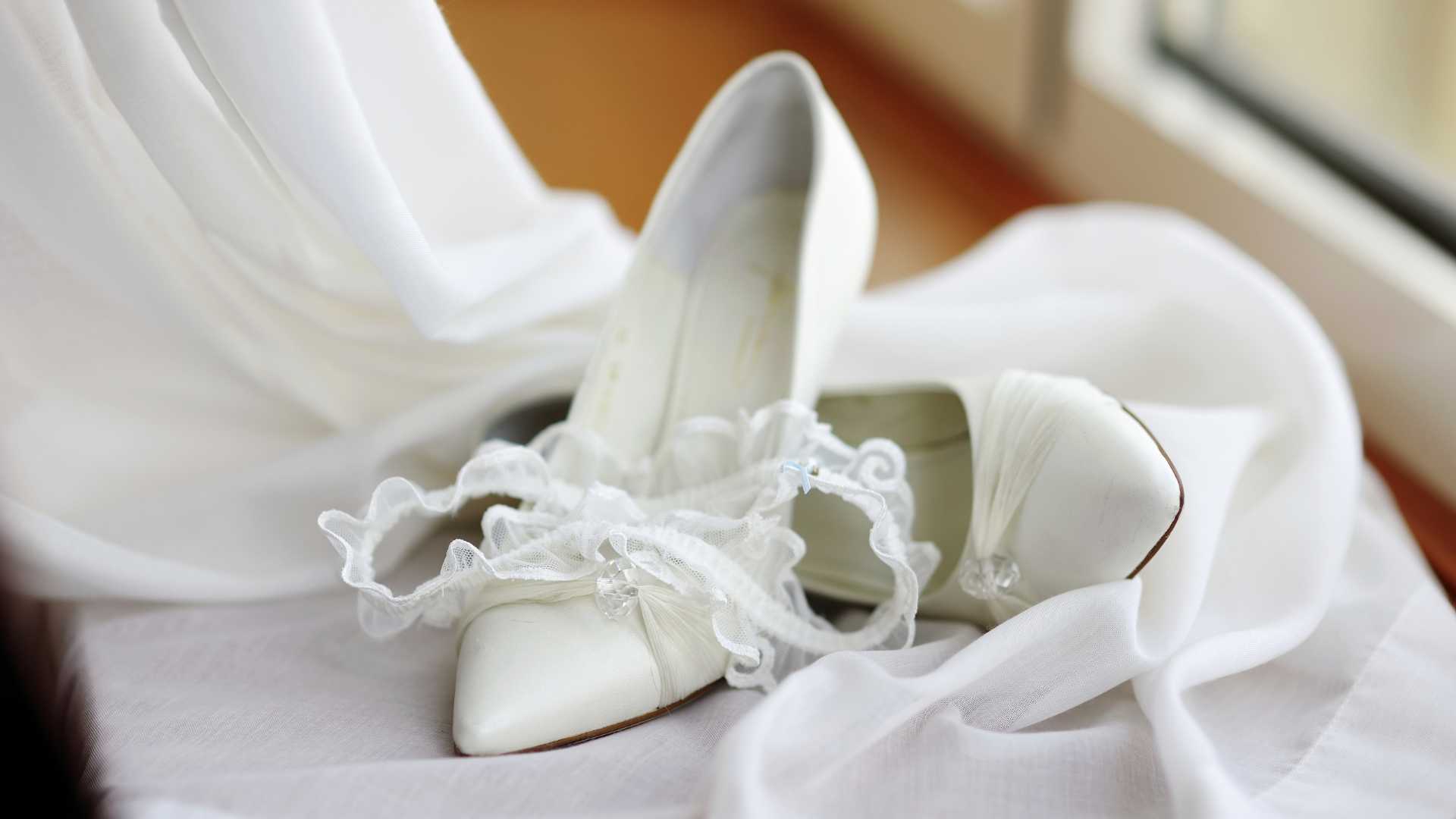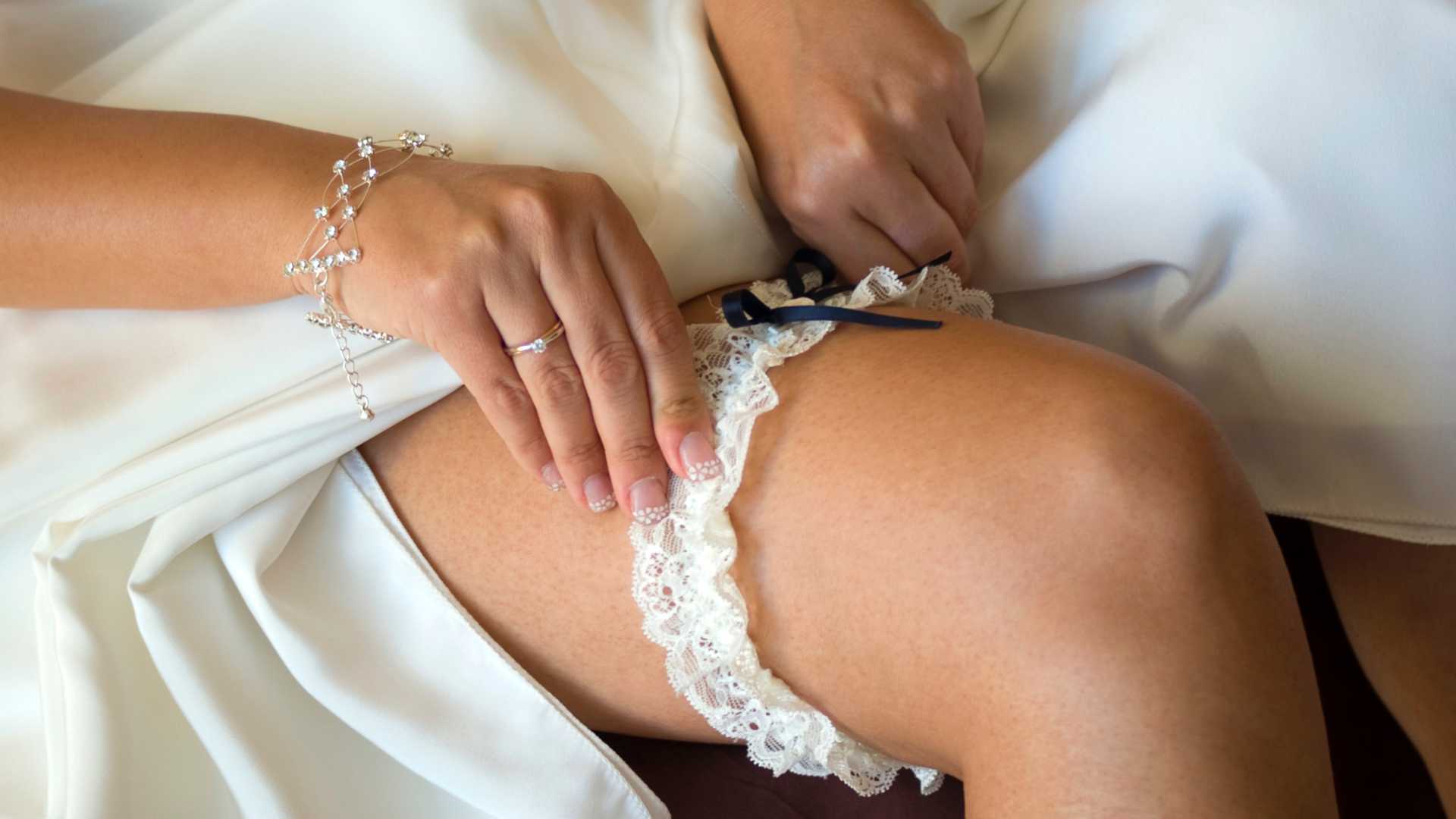When I got married at Vogue Ballroom in 2017, I remember looking at every detail of my wedding attire, wondering how much of it was just tradition and how much of it really meant something special to me. One item that stood out was my bridal garter. I had never really given it much thought before, but as I slipped it on, I couldn’t help but be intrigued by its history and meaning. Why did brides wear garters? What was the real symbolism behind this small but significant accessory?
Over the years, I’ve had the chance to talk to many brides about their choices for wedding attire, and the bridal garter always sparks a conversation. Some brides choose it for tradition, some for fun, and others simply because it adds that little extra touch to their ensemble. Whether you’re
The History Behind the Bridal Garter
The tradition of the bridal garter isn’t just a quirky custom—it’s a centuries-old practice with deep roots in folklore, superstition, and even the chaos of medieval weddings. When I worked with a couple from the Dandenong Ranges, we discussed everything from wedding bouquets to garter styles. As we explored the garter tradition, I was reminded of just how far back this wedding accessory goes.
Another reason the garter became so significant has to do with proving the marriage had been consummated. In some parts of Europe, after the vows were exchanged, the wedding guests would escort the couple to their bedchamber to witness the “bedding ceremony.” Yes, it sounds a bit awkward by today’s standards, but back then, it was a legitimate way to prove that the marriage was real. The garter could serve as a token, thrown out of the bedroom window, signalling that the deed had been done. It’s hard to imagine the full extent of the tradition, but in some cases, the garter was even used to cover the bride’s leg as a form of modesty during this ritual. It’s fascinating to think that what we now see as a romantic, slightly cheeky tradition started with such a utilitarian and, well, strange purpose.
Wedding Garter Symbolism: What Does the Garter Mean Today?
The wedding garter isn’t just a fun accessory to wear; it holds significant symbolic meaning, especially when we look at its history. In centuries past, the garter was deeply connected to concepts of purity and chastity. When I worked with a bride from Essendon, she told me that, despite the modern twist on the tradition, the idea of purity was one reason she had chosen to wear a garter. For her, it was a symbolic rite of passage, marking her transition from single life into marriage.
Back in the day, the garter was believed to represent the bride’s maidenhood. The act of removing it symbolised her shift into a new chapter, from a young woman to a wife. This was a big deal in times when society placed such an emphasis on a woman’s purity before marriage. The garter toss—traditionally done by the groom—also reflected this passage. In a way, it was an overt display of the bride’s readiness for this new life with her partner.
The Garter Toss and Its Role in Marriage Superstitions
While the symbolism of purity and chastity might seem outdated to many modern couples, the garter toss remains one of the most iconic traditions at wedding receptions. Growing up, I saw this ritual play out at nearly every wedding I attended. The groom removes the garter from the bride’s leg and tosses it to a group of single men. Whoever catches it is said to be the next to get married. I’ve even seen couples tweak this by incorporating fun twists. One bride, from a wedding I coordinated in Malvern, decided to have her groom toss the garter and the bouquet simultaneously. It was a hit and really kept the energy high during the reception.
But the garter toss isn’t just about superstition. It’s a playful tradition, adding an element of fun and light-heartedness to the reception. While some might dismiss it as an outdated ritual, it’s still a cherished part of many weddings, creating a memorable moment for guests. After all, there’s a certain magic in tradition, even if it’s wrapped up in a bit of cheeky fun.
Fertility, Luck, and Protection: The Symbolism of the Garter
When you think of the wedding garter, what might come to mind is a piece of lace or satin, perhaps adorned with a small bow. But its symbolism stretches far beyond the fabric. The garter has long been associated with good luck and fertility. This superstition is deeply rooted in ancient beliefs about the bride’s intimate attire. It was believed that possessing a piece of the bride’s clothing—especially something so personal—would transfer her luck, fertility, and positive energy. I’ve seen a few couples in Melbourne who incorporated this idea into their ceremonies. One bride chose to wear a garter made of lace from her grandmother’s wedding dress, as a way to honour the past and carry on the family’s luck and love.
The idea of the garter offering protection was another superstition that originated in medieval times. It was believed that wearing a garter could ward off evil spirits and keep them from interfering with the newlyweds. While we don’t necessarily believe in evil spirits these days, there’s something undeniably comforting about the idea of the garter offering protection and good fortune as the couple embarks on their new life together.
The Garter Toss Tradition: How It Works and What It Means
The Garter Toss Ritual Explained
The garter toss is one of those wedding traditions that never fails to get guests talking. I remember the first time I saw a garter toss at a wedding in the Yarra Valley—everyone was on the edge of their seats, waiting to see who would catch it. The groom, with a cheeky grin on his face, kneels down and removes the garter from his bride’s leg. Then, with a dramatic flourish, he tosses it into the crowd of eager, single men.
The superstition says that the man who catches the garter will be the next to marry. It’s a fun and light-hearted tradition, and over the years, I’ve seen couples get creative with it. At one wedding in Fitzroy, for example, the bride and groom turned the garter toss into a mini game. The groom had to toss the garter into a hoop, with the man who caught it getting a “prize.” It was a brilliant way to mix tradition with a bit of friendly competition, and it certainly kept everyone entertained.
While this ritual might seem a bit out of place in modern weddings, it remains a beloved part of many celebrations. For some, the garter toss is more than just a game—it’s a way to include the groom’s friends in the fun, creating an unforgettable moment that everyone will talk about for years.
Alternative Garter Toss Traditions Around the World
While the garter toss is common in many weddings, you’ll find different takes on this tradition depending on the culture. For example, I once helped plan a wedding for a couple who had strong French roots. They decided to incorporate a French twist on the garter toss. Instead of the groom tossing the garter to a group of men, they auctioned it off to the highest bidder! The money raised went to their honeymoon fund, and it brought a whole new level of excitement to the reception. Guests were amused by the idea, and it became one of the highlights of the evening.
In Spain, I’ve seen yet another variation of the garter toss. Instead of tossing the garter, the groom and bride each cut a piece of the garter and auction it off for charity. It’s a fun way to raise a little money for a good cause, while still honouring the tradition in a modern, meaningful way.
Modern Alternatives to the Garter Toss
While some couples still hold onto the garter toss tradition, others are opting to skip it altogether. And that’s okay! I’ve worked with many couples in Melbourne who decided to ditch the garter toss because they felt uncomfortable with the ritual or just didn’t think it fit with the vibe of their wedding. In place of the toss, some couples have chosen fun alternatives, like a “first dance challenge,” where the bride and groom show off their best dance moves or even engage in a silly game of trivia about each other. It’s all about finding what feels right for you.
But for those who want to keep the spirit of the garter toss alive without the awkwardness, some have opted to involve children in the fun. At a wedding in Brunswick, the couple had the youngest member of the wedding party toss the garter, creating a light-hearted, child-friendly alternative that kept things playful.
Should You Wear a Garter? Making the Decision
Reasons to Skip the Garter Tradition
While many brides love the tradition of wearing a garter, it’s not a must-do for everyone. I’ve worked with plenty of couples who have decided to skip this custom altogether, and there’s absolutely no harm in that. Weddings are personal, and each couple has the right to pick and choose what traditions they want to include. For example, I worked with a bride from Elwood who felt uncomfortable with the whole idea of the garter toss. She didn’t like the idea of her new husband publicly removing her garter and tossing it to a group of single men—it just didn’t sit right with her.
If you feel similarly, you’re not alone. Some brides choose not to participate because they feel the tradition is outdated, awkward, or simply doesn’t align with their style. There’s also the fact that some couples just prefer to skip the garter toss due to its gendered nature. The whole “removal of the garter” can feel too intimate or uncomfortable for some, and that’s perfectly okay.
Beyond the garter toss, some brides also opt out of wearing a garter simply because they don’t like the aesthetic. Maybe you’re more into modern, minimalist wedding attire, and the thought of wearing an extra accessory just doesn’t appeal. At the end of the day, your wedding is about what makes you feel good, so if the garter isn’t for you, don’t stress. There are plenty of other ways to make your wedding day unique and personal without this tradition.
When the Garter Tradition Fits Perfectly into Your Wedding
For others, the garter tradition is a fun and meaningful part of the wedding day. When I was planning my own wedding at Vogue Ballroom, I knew I wanted to wear a garter. It was one of those traditions I’d always thought was fun, and I had great memories of it from weddings I’d attended as a child. I went with a custom-made garter that matched my dress perfectly—an understated yet elegant piece that felt like it added just the right touch to my wedding ensemble.
The garter also allowed me to partake in the tradition of the garter toss, which was a fun moment for both me and my guests. It was a playful tradition that didn’t feel forced or awkward—it just added an extra bit of charm to the night. I’ve seen this happen with other brides too, where they make the tradition their own. The key is to make it meaningful for you and your partner, whether that means wearing the garter for sentimental reasons or simply because it feels right for your wedding style.
I’ve also worked with a couple in Moonee Ponds who incorporated a garter as a keepsake, much like a family heirloom. The bride wore a garter made from lace that had been passed down from her grandmother’s wedding dress. It was an emotional, deeply personal gesture. For her, the garter symbolised family connection and continuity—another layer of meaning to add to her big day.
How to Decide If the Garter Tradition Is Right for You
Ultimately, whether or not to wear a garter comes down to how you feel about it. Take a moment to ask yourself why you’re considering the tradition. Is it because you love the symbolism? Or is it more about carrying on a tradition that’s been passed down through the generations? Maybe you’ve always loved the idea of participating in the garter toss game, or perhaps you want to wear a garter as a fun surprise for your partner.
If you’re still unsure, consider having a conversation with your fiancé. For some couples, it’s a fun bonding experience to decide which wedding traditions they’ll keep or skip. Talk it through—whether you wear a garter or not, your wedding day will be memorable because it’s personal to both of you.
When I reflect on the significance of the garter, I realise it’s not just a tradition that’s survived over centuries—it’s a symbol that’s continuously evolving. Whether it’s tied to good luck, fertility, or a fun reception ritual, the garter still has a place in modern weddings, but it’s entirely up to the couple how they choose to incorporate it.
For some, it’s a fun way to honour tradition and share a light-hearted moment with guests. For others, it’s a deeply sentimental piece of bridal attire, carrying personal significance and family history. And for a few, it’s simply an accessory that completes their look, without much regard for the ritualistic elements.
At the end of the day, the decision to wear a garter—or not—is a personal one. It’s part of the broader tapestry of your wedding day and should reflect who you are as a couple. Whether you choose to stick with tradition or create your own version of it, your wedding is about making the day uniquely yours.




